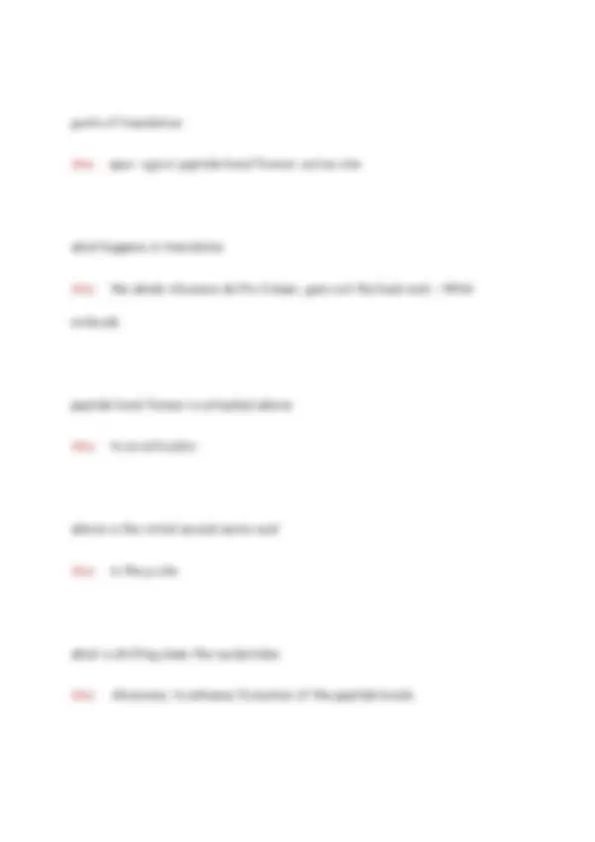






























Study with the several resources on Docsity

Earn points by helping other students or get them with a premium plan


Prepare for your exams
Study with the several resources on Docsity

Earn points to download
Earn points by helping other students or get them with a premium plan
Community
Ask the community for help and clear up your study doubts
Discover the best universities in your country according to Docsity users
Free resources
Download our free guides on studying techniques, anxiety management strategies, and thesis advice from Docsity tutors
This biol 250 final exam review covers fundamental biology concepts, including contributions from Hooke, Leeuwenhoek, Linnaeus, Schleiden, Schwann, Pasteur, and Koch. Key concepts include cell theory, binomial nomenclature, and Koch's postulates. It also covers basic chemistry: atoms, molecules, compounds, chemical bonds, water properties, carbohydrates, lipids, proteins, and nucleic acids. Prokaryotic and eukaryotic cells, cell wall structures, metabolism, and enzyme function are also discussed. This review helps students prepare for their final exam by reinforcing core biological principles, providing a concise summary of essential topics.
Typology: Exams
1 / 36

This page cannot be seen from the preview
Don't miss anything!





























Robert Hooke Ans: developed the first microscope, used to look at plant cells, first to use the term cells-- looked like what monks lived in Anton Van Leeuwenhoek Ans: father of microbiology first to look at living material-- scraped his teeth and saw that sick people had different microogranisms than his did Carolus Linnaeus Ans: binomial nomenclature schleiden and schwann
Ans: formulated the cell theory-- cells are fundamental unit of life and carry out functions of all living things Louis Pasteur Ans: swan flask experiment-- if the flask was tipped then it would come in contact with particles and growth would occur immediately Koch's postulates Ans: When determining the causative agent of disease...
Ans: two or more atoms combied-- O compound Ans: multiple elements- C6H12O atomic weight Ans: sum of protons and neutrons atomic number Ans: sum of protons in the nucleus cations Ans: lose an electron when joined with another atom, become more positively charged anion Ans: gain an electron, become more negatively charged
isotopes Ans: atoms within elements that have different number on neutrons-- ex. carbon12,13, gram molecular weight Ans: adding based on atomic weights Avogadro's number Ans: 6.023x10^ ionic bond Ans: outermost electrons are transferred from one orbital to another covalent bond Ans: sharing on electrons between orbitals-- certain arrangements are favorable and can hold the structure of compounds together
carbohydrates Ans: main source of energy for most living things levels of carbohydrates Ans: monosaccharides- glucose disaccharides- lactose polysaccharides- starch/glycogen common functional groups Ans: OH: hydroxyl groups CO: carbonyl groups COOH: carboxyl groups NH2: amino groups PO4: phosphate groups backbone of nucleic acid made up by which carbohydrates Ans: deoxyribose and ribose
Ans: sugar backbone, nitrogenous case high energy bonds--essential to enhance energy
characteristics of prokaryotes Ans: lack a nucleus lack membrane bound organelles-- endoplasmic reticulum, chloroplasts, golgi apparatus, mitochondria, etc. no membrane that surrounds and separate genetic info unicellular what are the two prokaryotic domains Ans: bacteria and archaea Eukaryotes Ans: have nucles and membrane bound organelles size shape and arrangement of eukaryotes Ans: small-- most around .5-2 mm can be cocci, bacilli, vibrioid (comma shaped) or spirrilium (squigly)
Ans: to evaluate differences in cell wall structure steps of gram staining Ans: thin smear on glass slide and heat fix it w/ flame to allow them to adhere to the slide
archae cell wall Ans: made up of pseudomurein-- made on sinsistent muramic acid, does not have alternating nags and nams cell membrane functions of archaea Ans: 1. regulate movement of materials in and out of cells
internal structure of prokaryotes Ans: cytoplasm, ribosomes, endospores cytoplasm Ans: makes up the aquatic environment of the cell, 4/5 water, 1/5 substance (salt, enzymes, proteins, lipids) ******ribosomes come back to this Ans: prok: 30s+50s=70s euk: 40s+60s=80s S stands for... Ans: svedburg units-- to describe molecular weight small subunit Ans: 16s rRNA+21 proteins= 1540 nt
large subunit Ans: 5s rRNA + 23s rRNA +31 proteins=120 nt endospores Ans: resting stage to enhance survival over significant time makeup of eukaryotic cells Ans: nucleus: rough er on outside, ribosomes making it rough smooth ER: inside-- lysosomes mitochondria: power house of cell, makes ATP chloroplast: photosynthesis endosymbiotic theory Ans: 1. strucutre of mitochondria and chloroplast are about the same size as prokaryote
redox reaction Ans: 2H2+O2-->2H2O a reaction in which both reduction and oxidation take place denaturation of enzyme Ans: increase in temp-- enzymatic structure is denatured bc the temp is higher so enzyme can no longer work the same endoenzymes Ans: produced and maintained in cells exoenzymes Ans: made inside cell but live outside to do things coenzymes Ans: non-protein organic molecules that are synthesized from vitamins
feedback inhibition Ans: a kind of reversible noncompetitive inhibition that regulates the rate of many metabolic pathways non-competitive inhibitors Ans: attach to the enzyme at an allosteric site which distort the tertiary protein structure and alter the shape of the active site glycolysis Ans: an anaerobic metabolism four take homes of glycolysis Ans: 1. substrate level phosphorylation (ATP--glucose)